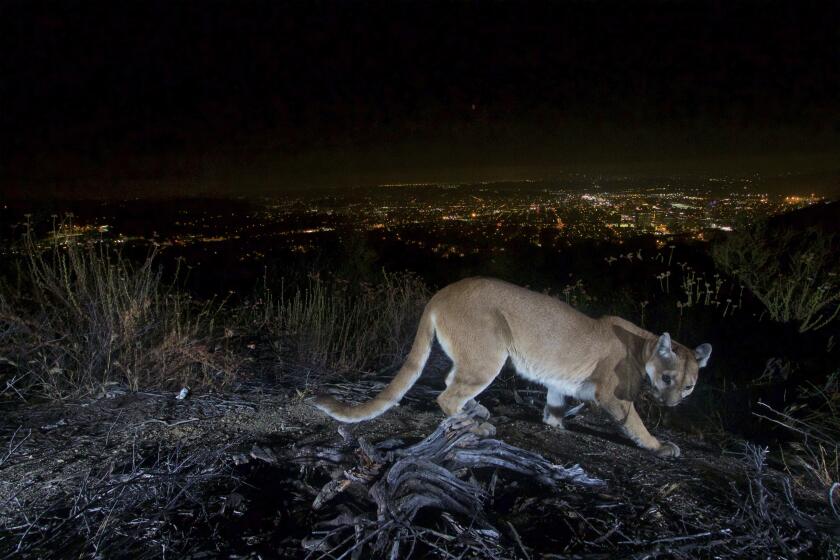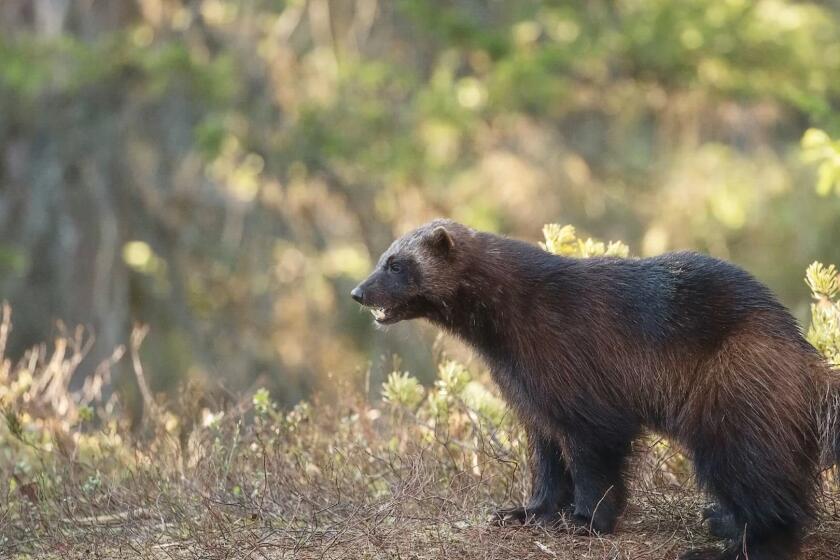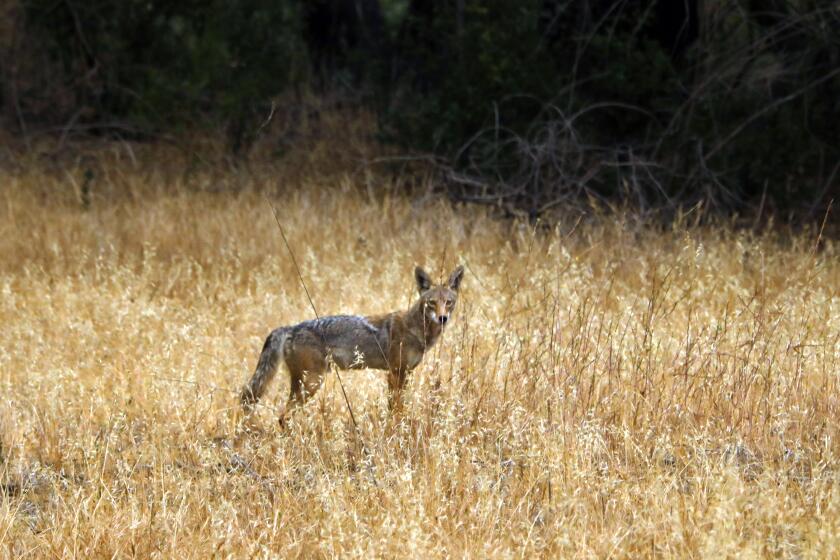Rare Songbird Offers Sour Note for Builders
The discovery of a rare songbird in Moorpark’s brushy hillside sage may not have been developer Mike Greynald’s worst nightmare, but it didn’t exactly make his day.
“I don’t know if pain is the right word. But is it something a builder wants to find on his property? Obviously not,” said Greynald, a general partner in Calabasas-based Morrison Homes.
Since the 1995 sightings of two pairs of coastal California gnatcatchers--the first confirmed in Ventura County since the 1920s--Greynald has scrapped his initial blueprint for a 445-acre residential community in north Moorpark.
Now he plans on setting aside nearly one-quarter of the property--100 acres--to remain in coastal sage scrub, the rapidly diminishing habitat where gnatcatchers thrive. The bird preserve had been destined for 60 homes and a church, school or some other institution, he said.
Greynald still hopes to put 583 houses on the rest of the parcel, nearly the same number as before. But he said those upscale homes will probably cost more and be more closely clustered because of the gnatcatcher set-aside area and the expense of having to reconfigure the project.
While Greynald and other Moorpark-area developers are less than thrilled with the prospects of building around a flourishing flock of sweet-voiced thrushes, biologists have hailed the discovery as another sign the gnatcatcher is finally making a comeback, not dying away.
The bird--found only in Southern California and northern Baja--is on a federal list of threatened species and is also considered a “species of concern” by the state because two-thirds of its sage habitat has been lost to urban development.
But a recent federal study indicates coastal gnatcatchers are increasing in number and that there are now about 2,900 pairs in the six Southland counties, up from about 2,560 when the bird was first listed as threatened under the Endangered Species Act four years ago.
The recent discovery of gnatcatchers in Moorpark, Sylmar and Pasadena suggests the bird may be migrating up the coast. Previously, they had been seen no farther north than the Whittier and Montebello hills in southeastern Los Angeles County.
“It’s encouraging that the species still exists here, where there is a fair amount of habitat remaining, so there is a little more cushion against the prospects of extinction,” said biologist Kate Symonds of the U.S. Fish & Wildlife Service in Ventura.
That habitat--marked by sage, buckwheat, coyote bush and beavertail cactus known as “soft chaparral”--is found over thousands of hillside acres from Simi Valley to Ventura, she said.
“But it’s difficult to say if there is a real increase in gnatcatchers,” Symonds added. “The question is: Is this really happening, or do we just find more because we’re doing more biological surveys on development sites that reach more into their hillside habitat?”
Indeed, on a recent afternoon, Symonds could not roust the elusive gnatcatcher on Greynald’s property, despite the biologist’s own persistent call of “pish, pish, pish”--the sound of an avian intruder that usually prompts gnatcatchers to respond in alarm.
There were, for all to see, coopers and red-tailed hawks, turkey vultures and the rufus-sided towhee, a robin-sized bird with rust-colored sides. But no sign of the tiny blue-gray gnatcatchers.
*
Regardless, Ventura County is dealing with its first sighting in 73 years of this tiny bird with a song as sweet as a kitten’s mew and a sound similar to it.
In other jurisdictions, mainly Orange and San Diego counties, “gnatcatcher wars” stalled projects for several years until agreements in 1996 and 1997 created preserves of tens of thousands of acres to protect the sage habitat where the birds nest almost exclusively.
Symonds said there are no plans for a large preserve in Ventura County, because only the two pairs of gnatcatchers and their offspring are known to live here. During two separate bird watches last year, eight to 12 chicks were seen, she said.
“But this year we’ve only seen the two pairs and one juvenile,” Symonds said. “So it’s not clear where the remaining birds are, whether they were lost to predators or were not making themselves conspicuous.”
Even though their feathers blend into the gray-green sage, the birds can often be detected by their telltale song, Symonds said. “That’s their characteristic sound during the breeding season,” she said. “Birds are much more vocal then. They’re attracting mates and defending their nests against scrub jays.”
Surveys of nearby properties where large developments are planned--including the huge 3,221-home Messenger project--have turned up no more gnatcatchers, said Nelson Miller, Moorpark community development director.
But scientists say Happy Camp Canyon, near Greynald’s Morrison-Fountainwood-Agoura project, and the mountainous area between Moorpark and the Santa Clara River have plenty of sage habitat that could sustain the insect-eating birds.
*
If more gnatcatchers are found, builders can follow Greynald’s model on how to react. First, he ordered more biological studies to confirm the extent of the bird’s population and to work with Symonds to draft a plan to preserve its habitat.
“In today’s world, we have an environmental checklist of things we have to do, just like we’ve always done for things like schools and roads,” he said.
Then Greynald went back to the drawing board and changed his proposal.
“The birds were located in our original open space area,” he said, “so we just moved those [60] homes farther back.”
Symonds said Greynald made the decision quickly during their first meeting last summer. “He said, ‘Why don’t we just draw a line here and this will be gnatcatcher and this won’t.’ We said, ‘Great.’ He was easy to work with.”
The portion of the site to be left to the birds would have been hard to develop regardless, owing to its very rugged terrain, with steep hills and deep ravines. Leaving it in open space may even become a selling point, Symonds said, because new residents can use the area for hiking.
An odd twist, Greynald said, is that the gnatcatchers might not have been discovered at all if he had not hired an Orange County biologist familiar with the controversial bird to do his biological survey. “These two pairs are so isolated from the main population,” he said. “And frankly, people here probably haven’t looked for these birds in the past.”
In setting up the gnatcatcher preserve, Greynald is part of a trend in which developers donate land or money to save threatened plants or wildlife found on building sites.
*
Miller, the Moorpark planner, said he worked with such habitat banks in regards to birds, turtles and rats in Riverside and San Diego counties.
In Moorpark, Greynald joins two other developers who are setting aside land. Builders of the Carlsberg housing project have agreed to leave 20 acres next to the Tierra Rejada greenbelt in a natural state to help preserve the endangered lion’s pentachaeta plant. And developers of the $20-million Special Devices manufacturing plant have agreed to set aside 120 acres as a conservation easement, Miller said.
Even with such preserves, however, Symonds said much is unknown on whether threatened species will flourish and spread to other areas. That is especially true for preserves surrounded by development, as will be the case in Greynald’s project.
“There are only bits of information about the gnatcatcher’s ability to disperse when there is development on different sides,” she said.
On Greynald’s site, natural ravines will be left clear, giving the birds direct ground access to Happy Camp Regional Park, she said. But when a planned freeway connector is built, it could block that corridor.
Miller said he does not believe that surrounding the gnatcatcher preserve with houses should be a problem.
“Birds can fly,” he said. “That may be different for something like a rodent or a reptile, which are confined to the ground. But what sort of connectivity is necessary [for gnatcatchers] is an issue that’s not been entirely resolved.”
All involved with the Greynald project--the developer, the city, federal biologists--are trying to keep details of the gnatcatchers’ precise location quiet, fearing the birds might be harmed.
There is another potential problem, Symonds said. She is concerned nearby landowners might purposely destroy sage habitat on their property to keep the troublesome gnatcatcher away.
“We met recently with a nearby landowner considering development of his parcel,” Symonds said. “And I noticed that a section adjacent to Mike Greynald’s property had been graded and the habitat cleared.”
Just when Greynald will go forward with his plan is unclear, though Miller said he believes it will be submitted for review in two or three months.
Greynald refused any such predictions. “I’m not a betting man on this project anymore,” he said. “Everything changes by the day.”
More to Read
Start your day right
Sign up for Essential California for news, features and recommendations from the L.A. Times and beyond in your inbox six days a week.
You may occasionally receive promotional content from the Los Angeles Times.






